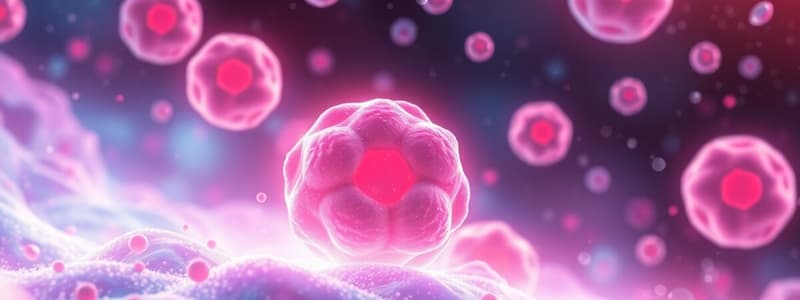Podcast
Questions and Answers
What is the primary function of eosinophils?
What is the primary function of eosinophils?
- Inflammatory response regulation
- Histamine release
- Destruction of bacteria
- Destruction of parasites (correct)
Which condition is most commonly associated with eosinophilia worldwide?
Which condition is most commonly associated with eosinophilia worldwide?
- Parasitic infections (correct)
- Idiopathic conditions
- Allergic disorders
- Neoplastic disorders
In which conditions is isolated basophilia more likely to occur?
In which conditions is isolated basophilia more likely to occur?
- Acute allergic reactions
- Chronic myelogenous leukemia (correct)
- Hematological neoplasms
- Severe infections
What is the normal percentage range of monocytes found in a peripheral blood smear?
What is the normal percentage range of monocytes found in a peripheral blood smear?
What is a major function of monocytes once they migrate to tissues?
What is a major function of monocytes once they migrate to tissues?
What is a common cause of reactive eosinophilia in developed countries?
What is a common cause of reactive eosinophilia in developed countries?
What component primarily causes the elevation of basophil counts in reactive conditions?
What component primarily causes the elevation of basophil counts in reactive conditions?
Monocytes contain granules in their cytoplasm that are responsible for which activity?
Monocytes contain granules in their cytoplasm that are responsible for which activity?
What percentage of circulating white blood cells are neutrophils in adults?
What percentage of circulating white blood cells are neutrophils in adults?
Which function do neutrophils NOT perform?
Which function do neutrophils NOT perform?
What is the primary characteristic of mature neutrophils compared to myeloid precursors?
What is the primary characteristic of mature neutrophils compared to myeloid precursors?
What term describes an increase in the absolute number of white blood cells?
What term describes an increase in the absolute number of white blood cells?
Which of the following changes occurs in neutrophils in response to chemoattractants?
Which of the following changes occurs in neutrophils in response to chemoattractants?
Which disorder is associated with lymphocytosis?
Which disorder is associated with lymphocytosis?
What effect does the Epstein–Barr virus (EBV) have on lymphocyte populations?
What effect does the Epstein–Barr virus (EBV) have on lymphocyte populations?
What morphological feature differentiates infectious mononucleosis from other reactive lymphocytoses?
What morphological feature differentiates infectious mononucleosis from other reactive lymphocytoses?
What are the two main pools of mature neutrophils after they leave the marrow?
What are the two main pools of mature neutrophils after they leave the marrow?
Which process allows marginating neutrophils to enter tissues?
Which process allows marginating neutrophils to enter tissues?
What is the approximate half-life of circulating neutrophils in the bloodstream?
What is the approximate half-life of circulating neutrophils in the bloodstream?
What ultimately happens to neutrophils that remain in tissues and are not used in an inflammatory process?
What ultimately happens to neutrophils that remain in tissues and are not used in an inflammatory process?
Which of the following phases is NOT part of neutrophil phagocytosis?
Which of the following phases is NOT part of neutrophil phagocytosis?
What is the term for the random and nondirectional movement of neutrophils along vessel endothelium?
What is the term for the random and nondirectional movement of neutrophils along vessel endothelium?
What is the process called that directs neutrophils towards a site of injury using chemical signals?
What is the process called that directs neutrophils towards a site of injury using chemical signals?
Which mechanism increases the rate of neutrophil migration towards an inflammatory site?
Which mechanism increases the rate of neutrophil migration towards an inflammatory site?
What condition can be a secondary cause of neutropenia?
What condition can be a secondary cause of neutropenia?
Which of the following is a characteristic of Chediak-Higashi syndrome?
Which of the following is a characteristic of Chediak-Higashi syndrome?
Which of the following defects affects neutrophil motility?
Which of the following defects affects neutrophil motility?
What is typically observed in a peripheral blood smear of a patient with functional defects of neutrophils?
What is typically observed in a peripheral blood smear of a patient with functional defects of neutrophils?
Which deficiency can lead to neutropenia as a secondary condition?
Which deficiency can lead to neutropenia as a secondary condition?
What management is typically required for patients with Chediak-Higashi syndrome during infection?
What management is typically required for patients with Chediak-Higashi syndrome during infection?
What percentage of eosinophils is typically found in normal peripheral blood smears?
What percentage of eosinophils is typically found in normal peripheral blood smears?
Which of the following is NOT a type of defect that can characterize functional disorders of neutrophils?
Which of the following is NOT a type of defect that can characterize functional disorders of neutrophils?
What is one of the primary roles of proteins secreted by monocytes?
What is one of the primary roles of proteins secreted by monocytes?
Which condition is generally associated with reactive monocytosis?
Which condition is generally associated with reactive monocytosis?
What defines absolute lymphocytosis?
What defines absolute lymphocytosis?
How does relative lymphocytosis differ from absolute lymphocytosis?
How does relative lymphocytosis differ from absolute lymphocytosis?
Which type of lymphocyte is described as benign and transformed?
Which type of lymphocyte is described as benign and transformed?
What is NOT a function of monocyte secreted proteins?
What is NOT a function of monocyte secreted proteins?
Which disorder is not associated with absolute monocytosis?
Which disorder is not associated with absolute monocytosis?
In adults, what percentage range do lymphocytes comprise of the total WBC count?
In adults, what percentage range do lymphocytes comprise of the total WBC count?
Study Notes
Eosinophils
- Eosinophils are white blood cells that contain secondary granules rich in major basic protein.
- These granules help to destroy parasites and play a role in immediate hypersensitivity reactions.
- Eosinophilia, an increased number of eosinophils, can be caused by neoplastic, reactive, or idiopathic factors.
- Parasitic infections are the most common cause worldwide, while allergic disorders are most common in developed countries.
Basophils
- Basophils are white blood cells that make up 1% to 2% of peripheral blood.
- They are uncommon in isolation but can increase in response to allergy, hypersensitivity, or inflammation.
- This is due to histamine, a major component of basophilic granules.
- Basophilia can also indicate a malignant process, particularly in myeloproliferative neoplasms, where the count is significantly higher due to elevated white blood cell count.
- Chronic myelogenous leukemia (CML) is the most common cause of basophilia.
Monocytes
- Monocytes constitute 2% to 9% of peripheral blood.
- They function in phagocytosis, antimicrobial activities, tissue repair, and other functions after migrating to tissue.
- These cells contain fine granules which contribute to the destruction of microbes.
Neutrophils
- Neutrophils are the most numerous leukocytes, accounting for 50% to 70% of circulating white blood cells in adults.
- They act as phagocytes capable of ameboid movement into tissues to engulf and destroy bacteria or fungi, making them the first responders to infection.
- They also mediate inflammatory processes.
- Mature neutrophils are smaller than myeloid precursors, enhancing their mobility and deformability.
- Neutrophils exist in two pools: marginating and circulating.
- The marginating pool, not measured by peripheral blood sampling, consists of cells adhering to vessel endothelium within the vascular spaces.
- They enter tissues by diapedesis in response to inflammation or injury.
- Neutrophils in the circulating pool leave the blood by random migration after a half-life of ~7 hours.
- These neutrophils do not return to the bloodstream from tissues.
- After entering tissues, neutrophils are believed to remain for several days, eventually dying by apoptosis or being destroyed by phagocytic cells.
- Neutrophil function during phagocytosis occurs in three phases: migration and diapedesis; opsonization and recognition; and ingestion, killing, and digestion.
- Neutrophils in the marginating pool move along vessel endothelium randomly, a process called locomotion.
- This movement becomes directional in response to chemoattractants, known as chemotaxis.
- Chemoattractants can accelerate neutrophil migration, a phenomenon called chemokinesis.
- Neutropenia can be acquired secondary to aplastic anemia, malignancy of the bone marrow, or dietary deficiencies in B12 or folate.
- Congenital neutropenias, rare disorders, are characterized by defective or deficient neutrophil production in the bone marrow.
- Qualitative neutrophil disorders involve hereditary abnormalities in function, leading to bacterial infections.
- Functional defects may be acquired or inherited, classified by their type: phagocytic/killing defects, granule structure and function defects, defects affecting chemotaxis and motility, and adhesion defects.
- Chediak–Higashi syndrome, a rare neutrophil disorder, is characterized by recurring bacterial infections, partial albinism, and the presence of giant lysosomal granules in nucleated cells.
- Management involves prophylactic antimicrobial therapy and aggressive intravenous treatment during infection.
Lymphocytes
- Lymphocytosis indicates an increased number of lymphocytes in the peripheral blood.
- In adults, lymphocytes represent 20% to 40% of the relative differential count.
- Relative lymphocytosis refers to an increased percentage of lymphocytes in a white blood cell differential.
- Absolute lymphocytosis refers to the total number of lymphocytes present.
- Reactive lymphocytes are transformed or benign lymphocytes.
- Reactive lymphocytes and normal lymphocytes vary in size, shape, and immunophenotypic markers.
- Malignant lymphocytes are cancerous lymphocytes.
Monocytes (Continued)
- Monocytes secrete proteins that regulate hematopoiesis, stimulate inflammatory reactions, remove infectious organisms, senescent blood cells, and modulates the immune function.
- They also stimulate host defense against tumor cells.
- Reactive monocytosis is associated with chronic infections, autoimmune diseases, splenectomy, and various malignancies.
- Absolute monocytosis is found in malignant hematopoietic disorders such as chronic myelomonocytic leukemia (CMML), chronic myelogenous leukemia (CML), acute monocytic leukemia, and acute myelomonocytic leukemia (AMML).
Studying That Suits You
Use AI to generate personalized quizzes and flashcards to suit your learning preferences.
Related Documents
Description
This quiz explores the characteristics and functions of eosinophils and basophils, two types of white blood cells. You will learn about their roles in immune responses, associated conditions, and their relevance in allergic and parasitic reactions. Test your knowledge on these immune cells and their importance in health and disease.




